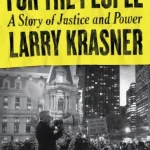Indefinite: Doing Time in Jail
 Author: Michael L. Walker
Author: Michael L. Walker
Publisher: Oxford University Press, 2022. 288 pages.
Reviewer: Madalyn Wasilczuk | March 2023
I held my breath as Michael J. Walker described the details of his birthday arrest in 2008. A former public defender, I tensed and muttered an expletive when replied to the intake officer, “I don’t know what I might do.” The officer asked him whether he might harm himself, and I knew where that answer would lead him: into a stiff, scratchy blanket-like gown in a suicide-watch cell. Michael’s cell was covered in feces and “painted in a familiar shade: industrial agony.”
His story took me back in time to Philadelphia, where on State Road I interviewed a man, little more than a boy, on suicide watch at one of the county’s jails. The cell he was in was like a fish tank built for humans, and from what I could tell, the quilt-blanket covering he was given, the same depressing shade of green Michael describes, did not close – and he was naked underneath. I had interviewed too many people to count in jail, but his condition still shocked me. When I got back to the office, I wondered aloud how anyone could think such humiliating conditions could possibly be good for someone’s mental health. I already knew the answer. Few care.
Walker’s Indefinite: Doing Time in Jail combines the personal and the political, the quantifiable and the ineffable, and in doing so, transports the reader into the visceral sensations of custody. Wielding field notes from his time in custody to tell detailed stories, Walker excels in recreating the world of the jail. Readers see, hear, smell, taste, and touch the institution, from the glaring lights and metal bunks to creative pizza recipes and foul smells from toilet etiquette unobserved. Walker, Michael, Mike, or Egypt, depending on who’s asking, writes at once an intimate and academic account of places across this country so frequently seen by some and rarely, if ever, considered by others. In fact, the lack of thought about jails, even as compared to also-neglected prisons, is part of what makes Walker’s contribution so important (Dolovich, 2012).
Today, Michael Walker is an Associate Professor of Sociology at the University of Minnesota – Twin Cities, but his sociological account of his own time in jail is told through three roles: subject, narrator, and sociologist. In Indefinite, Walker brings to life a vivid world that allows the reader to understand the “emotional, physical, and cognitive experiences of the jail as they are” shaped by the “moods, activities, people involved, motives and constraints” (p. 21) present in the jail organization. What Walker offers is accessible regardless of a person’s academic field, and the book’s characters and emotional resonance make it far more appealing for non-academic audiences. Though the author frames the social organization of Golden County’s jails by reference to sociological concepts and literature, he explains the concepts clearly so that readers without a background in the field will still be able to use that framing as a lens through which to peer into jail life.
Walker centers the affective and interpersonal aspects of “doing time,” as he calls it, leaning into feelings—and concepts of care—in ways that separate his work from famous carceral sociologies like Erving Goffman’s Asylums. The vignettes he offers to help readers understand the people, routines, and endurance strategies of jail are sharp, if occasionally dense. Walker does not proceed in chronological order, instead grouping stories based on the insights he gleans from them. By and large, this is a successful strategy – though, at times, the reader might lose her sense of place or time. This is not an accident. Walker acknowledges he intends his readers to experience the learning of jail’s rhythms, social structures, and codes as a disorienting process, as he did.
Though Walker is a sociologist by training, his work sits at the intersection of fields including law, psychology, and criminology. Scholars of the criminal process, no matter their background, will find Walker’s account insightful, though as if to anticipate remarks on his exceptionality, Walker notes that he has no more depth of understanding than others who have done time. Walker touches on bail, procedural due process, plea bargaining, the right to counsel, sentencing, and incarceration law, all germane to legal system professionals.
While Walker’s work shines brightest in its ability to access the reader’s senses and emotions, his attention to the details of jails’ structures, physical and social, debunks common prison stereotypes. The two most important, perhaps, are the roles of race and violence during incarceration. The racial categorization of Golden County “residents,” as Walker describes them, into “blacks, southsiders, and woods,” defies free world expectations of racialization in a way that challenges conventional accounts of race (p. 52). The jail’s emplaced racial constructions include Asians in the category of “blacks” (most of the time), while grouping indigenous and Latine people into the category “southsiders.” Intragroup tensions make these racialized groups difficult for some—the “paisas,” or recently-arrived Latine immigrants often belittled by other Latine southsiders, for example. The authority of white supremacists in the “woods” group, which includes other white people who do not subscribe to the “white power comrade” worldview, sometimes invited violence against the non-comrade white residents.
Walker also discusses how racial barriers often broke down outside the cell blocks, whether in trips to mental health, the trustee pod, or the pre-classification holding cells. The contingency of racial salience by place undermines the common conception that a racial order is necessary to prevent violence in carceral settings. Instead, Walker convincingly argues that race is a matter of administrative convenience, rather than a mediation of preexisting intergroup tensions.
Violence, often understood as endemic to carceral settings because of the inherent characteristics of the people inside them, serves a more ordered purpose in Walker’s telling. The social utility of violence is to discipline group members, often in order to prevent intergroup violence. At the same time, Walker describes how the conditions of jail life deplete residents’ capacities to self-regulate and handle problems in other ways. Jails enforce a state of near-constant hunger, sleep deprivation, and solitude, aggravated by the annoyances of batched living. The conditions Walker describes underscore how nonsensical it is to treat jails as places of rehabilitation.
Walker ends on what feels like a benediction: that perhaps the reader will learn from what he’s written. He remarks, “A foundational idea in sociological and social psychological research is that we are all trying to avoid discomforting feelings” (p. 236). As a lawyer and law professor, one who teaches in a clinic and the classroom, this point struck me as perhaps the most profound reason that legal education so rarely features voices subjected to the violence of law (Cover, 1985). We are discomforted by them.
It is profoundly discomforting to be reminded that continuances break spirits, that bail frays relationships and that we routinely starve those in custody of food, sunlight, mental stimulation, and of all the things that comprise recognition of one’s basic humanity. It also speaks to the profoundly unemotional and disembodied way that law is often taught—to the point that students internalize that distance and neutrality lack positionality and are not just the preferred, but the correct, way to practice law (Aiken, 2012). This is perhaps why I so often receive a request from students who want to practice in the criminal legal system for guidance on how to “not let it affect” them. Of course, to the extent that means maintaining a semblance of mental health, it is both an important goal and one that the characters of Indefinite, Walker included, share.
But when that crosses into a forgetting of suffering or a practiced disconnection from it, perhaps legal educators, students, and practitioners would do better to more often find themselves discomforted in our places of relative privilege. It is not only in the plight of others that Walker might discomfit those who work in the system. It also shines a light on our own shortcomings: as judges, public defenders, correctional officers, prosecutors, medical or mental health service providers . . . the list goes on. Academics, too, make a brief and unflattering cameo in Walker’s experiences with presenting his work. An invitation to introspection is here if we choose to take it.
Walker’s sensitive and nuanced account of “doing time” is essential reading for anyone making policy, serving on juries, voting, or simply living in the U.S. carceral state. For those of us working in and around the criminal and juvenile legal systems, it should be a required text.
References:
Jane H. Aiken, The Clinical Mission of Justice Readiness, 32 J.L. & Soc. Just. 231 (2012).
Robert M. Cover, Violence and the Word, 95 Yale L.J. 1601 (1985).
Sharon Dolovich, Teaching Prison Law, 62 J. Legal Educ. 218 (2012).
Madalyn K. Wasilczuk is an Assistant Professor of Law at the University of South Carolina School of Law.


